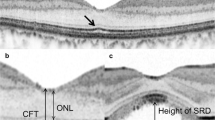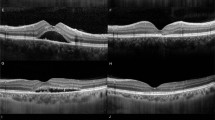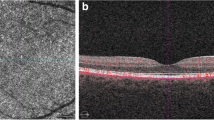Abstract
Purpose
To study morphologically and functionally the prognosis of damaged outer segments of the foveal photoreceptor layer in eyes with resolved central serous chorioretinopathy (CSC).
Methods
We studied retrospectively the medical records of 70 patients (74 eyes) with resolved CSC. Optical coherence tomography was used to detect the junctions between inner and outer segments of the photoreceptors (IS/OS) as a hallmark of the integrity of the outer photoreceptor layer.
Results
In 53 eyes (71.6%), the IS/OS line was clearly detected beneath the fovea immediately after resolution of the retinal detachment, with good visual acuity (VA). In the remaining 21 eyes (28.4%), however, the foveal IS/OS line could not be detected shortly after resolution of CSC, and VA was variable, ranging from 0.1 to 1.5 (median, 0.9). Of these 21 eyes, 15 had a follow-up examination with OCT, and in four the foveal IS/OS line was not detected at the follow-up and vision in these eyes remained poor. However, nine eyes showed recovery of the foveal IS/OS line during follow-up, and these eyes had substantial visual recovery.
Conclusions
Immediately after resolution of active CSC, although the IS/OS line cannot be detected beneath the fovea, it often shows restoration over time, with visual recovery, though in some eyes no restoration takes place and the prognosis remains poor.
Similar content being viewed by others
References
Spaide RF. Central serous chorioretinopathy. In: Holz FG, Spaide RF, editors. Medical retina. Berlin, Heidelberg: Springer; 2004. p. 77–93.
Cardillo Piccolino F, Eandi CM, Ventre L, et al. Photodynamic therapy for chronic central serous chorioretinopathy. Retina 2003;23:752–763.
Eandi CM, Chung JE, Cardillo-Piccolino F, Spaide RF. Optical coherence tomography in unilateral resolved central serous chorioretinopathy. Retina 2005;25:417–421.
Piccolino FC, de la Longrais RR, Ravera G, et al. The foveal photoreceptor layer and visual acuity loss in central serous chorioretinopathy. Am J Ophthalmol 2005;139:87–99.
Wang MS, Sander B, Larsen M. Retinal atrophy in idiopathic central serous chorioretinopathy. Am J Ophthalmol 2002;133:787–793.
Ojima Y, Hangai M, Sasahara M, et al. Three-dimensional imaging of the foveal photoreceptor layer in central serous chorioretinopathy using high-speed optical coherence tomography. Ophthalmology 2007;114:2197–2207.
Drexler W, Sattmann H, Hermann B, et al. Enhanced visualization of macular pathology with the use of ultrahigh-resolution optical coherence tomography. Arch Ophthalmol 2003;121:695–706.
Ko TH, Fujimoto JG, Schuman JS, et al. Comparison of ultrahigh- and standard-resolution optical coherence tomography for imaging macular pathology. Ophthalmology 2005;112:1922–1935.
Hangai M, Ojima Y, Gotoh N, et al. Three-dimensional imaging of macular holes with high-speed optical coherence tomography. Ophthalmology 2007;114:763–773.
Maruko I, Iida T, Sekiryu T, Saito M. Morphologic changes in the outer layer of the detached retina in rhegmatogenous retinal detachment and central serous chorioretinopathy. Am J Ophthalmol 2009;147:489–494.
Matsumoto H, Kishi S, Otani T, Sato T. Elongation of photoreceptor outer segment in central serous chorioretinopathy. Am J Ophthalmol 2008;145:162–168.
Fujimoto H, Gomi F, Wakabayashi T, et al. Morphologic changes in acute central serous chorioretinopathy evaluated by Fourierdomain optical coherence tomography. Ophthalmology 2008;115:1494–1500.
Costa RA, Calucci D, Skaf M, et al. Optical coherence tomography 3: automatic delineation of the outer neural retinal boundary and its influence on retinal thickness measurements. Invest Ophthalmol Vis Sci 2004;45:2399–2406.
Sano M, Shimoda Y, Hashimoto H, Kishi S. Restored photoreceptor outer segment and visual recovery after macular hole closure. Am J Ophthalmol 2009;147:313–318.
Spaide RF, Koizumi H, Freund KB. Photoreceptor outer segment abnormalities as a cause of blind spot enlargement in acute zonal occult outer retinopathy-complex diseases. Am J Ophthalmol 2008;146:111–120.
Chang LK, Koizumi H, Spaide RF. Disruption of the photoreceptor inner segment-outer segment junction in eyes with macular holes. Retina 2008;28:969–975.
Ojima Y, Tsujikawa A, Hangai M, et al. Retinal sensitivity measured with the Micro Perimeter 1 after resolution of central serous chorioretinopathy. Am J Ophthalmol 2008;146:77–84.
Ko TH, Fujimoto JG, Duker JS, et al. Comparison of ultrahigh- and standard-resolution optical coherence tomography for imaging macular hole pathology and repair. Ophthalmology 2004;111:2033–2043.
Arroyo JG, Yang L, Bula D, Chen DF. Photoreceptor apoptosis in human retinal detachment. Am J Ophthalmol 2005;139:605–610.
Lewis GP, Charteris DG, Sethi CS, Fisher SK. Animal models of retinal detachment and reattachment: identifying cellular events that may affect visual recovery. Eye 2002;16:375–387.
Matsumoto H, Sato T, Kishi S. Outer nuclear layer thickness at the fovea determines visual outcomes in resolved central serous chorioretinopathy. Am J Ophthalmol 2009;148:105–110.
Erickson PA, Fisher SK, Anderson DH, et al. Retinal detachment in the cat: the outer nuclear and outer plexiform layers. Invest Ophthalmol Vis Sci 1983;24:927–942.
Wilson DJ, Green WR. Histopathologic study of the effect of retinal detachment surgery on 49 eyes obtained post mortem. Am J Ophthalmol 1987;103:167–179.
Iida T, Hagimura N, Sato T, Kishi S. Evaluation of central serous chorioretinopathy with optical coherence tomography. Am J Ophthalmol 2000;129:16–20.
Kanis MJ, van Norren D. Integrity of foveal cones in multiple evanescent white dot syndrome assessed with OCT and foveal reflection analyser. Br J Ophthalmol 2006;90:795–796.
Sikorski BL, Wojtkowski M, Kaluzny JJ, et al. Correlation of spectral optical coherence tomography with fluorescein and indocyanine green angiography in multiple evanescent white dot syndrome. Br J Ophthalmol 2008;92:1552–1557.
Author information
Authors and Affiliations
Corresponding author
About this article
Cite this article
Ojima, Y., Tsujikawa, A., Yamashiro, K. et al. Restoration of outer segments of foveal photoreceptors after resolution of central serous chorioretinopathy. Jpn J Ophthalmol 54, 55–60 (2010). https://doi.org/10.1007/s10384-009-0766-4
Received:
Accepted:
Published:
Issue Date:
DOI: https://doi.org/10.1007/s10384-009-0766-4




